 | TODAY IN SCIENCE HISTORY
NEWSLETTER - 22 OCTOBER |
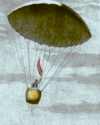 On 22 Oct 1797, the first parachute jump was made by André-Jacques Garnerin, released from a balloon 2,230-ft above the Parc Monceau, Paris. He rode in a gondola fixed to the lines of a 23-ft diameter parachute, which was supported by a wooden pole and had its 32 white canvas gores folded like a closed umbrella. Lacking any vent in the top of the parachute, Garnerin descended with violent oscillations, and suffered the first case of airsickness. On 22 Oct 1797, the first parachute jump was made by André-Jacques Garnerin, released from a balloon 2,230-ft above the Parc Monceau, Paris. He rode in a gondola fixed to the lines of a 23-ft diameter parachute, which was supported by a wooden pole and had its 32 white canvas gores folded like a closed umbrella. Lacking any vent in the top of the parachute, Garnerin descended with violent oscillations, and suffered the first case of airsickness. The article on Garnerin and Parachutes from Adventures in the Air: Being Memorable Experiences of Great Aeronauts (1877) gives the date of the jump as 18 Jun 1797, and from the Gardens of Tivoli. Since other sources give the date as 22 Oct, that is a discrepacy to be resolved. Still, the remainder of the narrative makes interesting reading about Garnerin. |
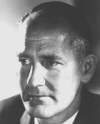 | In a sense, genetics grew up as an orphan. In the beginning botanists and zoologists were often indifferent and sometimes hostile toward it. 'Genetics deals only with superficial characters', it was often said. Biochemists likewise paid it little heed in its early days. They, especially medical biochemists, knew of Garrod's inborn errors of metabolism and no doubt appreciated them in the biochemical sense and as diseases; but the biological world was inadequately prepared to appreciate fully the significance of his investigations and his thinking. Geneticists, it should be said, tended to be preoccupied mainly with the mechanisms by which genetic material is transmitted from one generation to, the next. - George Beadle, American geneticist (born 22 Oct 1903).  |
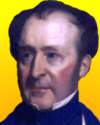 | Physical geography and geology are inseparable scientific twins. - Sir Roderick Impey Murchison, Scottish geologist (died 22 Oct 1871).  |
 | If any student comes to me and says he wants to be useful to mankind and go into research to alleviate human suffering, I advise him to go into charity instead. Research wants real egotists who seek their own pleasure and satisfaction, but find it in solving the puzzles of nature. - Albert Szent-Gyorgyi, Hungarian-American biochemist (died 22 Oct 1986).  |
| Before you look at today's web page, see if you can answer some of these questions about the events that happened on this day. Some of the names are very familiar. Others will likely stump you. Tickle your curiosity with these questions, then check your answers on today's web page. |
 | Charles Glen King, born 22 Oct 1896, was a biochemist who in 1932 isolated a vitamin after five years of painstaking research extracting components from lemon juice. The vitamin is also known as ascorbic acid, (a- = not, without; scorbus = scurvy),
 Can you name this vitamin? |
| Guillaume Le Gentil (1725-1792) was a French astronomer who attempted to observe a particular astronomical event by travelling to India in 1761. He failed to arrive in time due to an outbreak of war. He stayed in India to see the next occurrence of the event which came eight years later. This time, he was denied a view because of cloudy weather, and so returned to France. There, he found his heirs had assumed he was dead and taken his property.
 What event did he go to India to observe? |
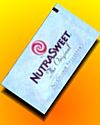 | On 22 Oct 1981, aspartame artificial sweetener was approved for tabletop use by the U.S. Food and Drug Administration. G.D. Seale marketed it as a low-calorie artificial sweetener without the bitter aftertaste of saccharin.
 By what tradename was aspartame marketed by G.D. Searle? |
 | On 22 Oct 1797, the first successful parachute jump was made by Andr�-Jacques Garnerin, from a balloon 2,230-ft above Paris. He used a 23-ft diameter parachute, but Garnerin descended with violent oscillations, and suffered the first case of airsickness.
 What design feature was missing from his parachute that caused the oscillations during the descent? |
When you have your answers ready to all the questions above, you'll find all the information to check them, and more, on the October 22 web page of Today in Science History. Or, try this link first for just the brief answers.
Fast answers for the previous newsletter for October 21: The decade including the year 1901 • cadavers • tunneling shield, the basic tool of underwater tunneling • Tennessee • Planck constant (h), the elementary charge (e), the Avogadro constant (NA), • 40 hours. |
 If you enjoy this newsletter, the website, or wish to offer encouragement or ideas, please send feedback by using your mail reader Reply button. If you enjoy this newsletter, the website, or wish to offer encouragement or ideas, please send feedback by using your mail reader Reply button.
Your click on a StumbleUpon, Google+ or Facebook social button on the site webpages is also a welcome sign of appreciation. Thank you for using them. |
To find citations for quotations go to the corresponding webpage by clicking on the “quotes” balloon icon. Sources for the thumbnails appear on today's webpage with the corresponding item.
� This newsletter is copyright 2013 by todayinsci.com. Please respect the Webmaster's wishes and do not put copies online of the Newsletter � or any Today in Science History webpage. (If you already have done so, please remove them. Thank you.) Offline use in education is encouraged such as a printout on a bulletin board, or projected for classroom viewing. Online, descriptive links to our pages are welcomed, as these will provide a reader with the most recent revisions, additions and/or corrections of a webpage. For any other copyright questions, please contact the Webmaster by using your mail reader Reply button. |
--
If you do not want to receive any more newsletters,
Unsubscribe To update your preferences and to unsubscribe visit
this link 


 On 22 Oct 1797, the first parachute jump was made by André-Jacques Garnerin, released from a balloon 2,230-ft above the Parc Monceau, Paris. He rode in a gondola fixed to the lines of a 23-ft diameter parachute, which was supported by a wooden pole and had its 32 white canvas gores folded like a closed umbrella. Lacking any vent in the top of the parachute, Garnerin descended with violent oscillations, and suffered the first case of airsickness.
On 22 Oct 1797, the first parachute jump was made by André-Jacques Garnerin, released from a balloon 2,230-ft above the Parc Monceau, Paris. He rode in a gondola fixed to the lines of a 23-ft diameter parachute, which was supported by a wooden pole and had its 32 white canvas gores folded like a closed umbrella. Lacking any vent in the top of the parachute, Garnerin descended with violent oscillations, and suffered the first case of airsickness. 



 Can you name this vitamin?
Can you name this vitamin?  What event did he go to India to observe?
What event did he go to India to observe? 
 By what tradename was aspartame marketed by G.D. Searle?
By what tradename was aspartame marketed by G.D. Searle? 
 What design feature was missing from his parachute that caused the oscillations during the descent?
What design feature was missing from his parachute that caused the oscillations during the descent?  If you enjoy this newsletter, the website, or wish to offer encouragement or ideas, please send feedback by using your mail reader Reply button.
If you enjoy this newsletter, the website, or wish to offer encouragement or ideas, please send feedback by using your mail reader Reply button. 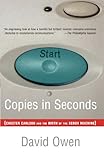

Δεν υπάρχουν σχόλια:
Δημοσίευση σχολίου